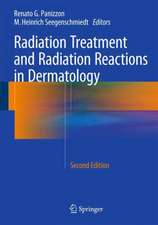Cellular Senescence and Tumor Suppression
Editat de Peter D. Adams, John M. Sedivyen Limba Engleză Paperback – 29 noi 2014
| Toate formatele și edițiile | Preț | Express |
|---|---|---|
| Paperback (1) | 1093.88 lei 6-8 săpt. | |
| Springer – 29 noi 2014 | 1093.88 lei 6-8 săpt. | |
| Hardback (1) | 1099.35 lei 6-8 săpt. | |
| Springer – 16 dec 2009 | 1099.35 lei 6-8 săpt. |
Preț: 1093.88 lei
Preț vechi: 1151.45 lei
-5% Nou
Puncte Express: 1641
Preț estimativ în valută:
209.34€ • 227.31$ • 175.84£
209.34€ • 227.31$ • 175.84£
Carte tipărită la comandă
Livrare economică 23 aprilie-07 mai
Preluare comenzi: 021 569.72.76
Specificații
ISBN-13: 9781489983565
ISBN-10: 1489983562
Pagini: 288
Ilustrații: XIII, 272 p. With 1 4-color insert.
Dimensiuni: 155 x 235 x 15 mm
Greutate: 0.41 kg
Ediția:2010
Editura: Springer
Colecția Springer
Locul publicării:New York, NY, United States
ISBN-10: 1489983562
Pagini: 288
Ilustrații: XIII, 272 p. With 1 4-color insert.
Dimensiuni: 155 x 235 x 15 mm
Greutate: 0.41 kg
Ediția:2010
Editura: Springer
Colecția Springer
Locul publicării:New York, NY, United States
Public țintă
Professional/practitionerDescriere
As cells mature they naturally stop dividing and enter a period called senescence. But cellular senescence can also be induced prematurely by certain oncogenes involved in cancer development. Cellular senescence, a growth-arrest program that limits the lifespan of mammalian cells and prevents unlimited cell proliferation, is attracting considerable interest because of its links to tumor suppression.
Cuprins
Introduction: J Sedivy. Section 1. Senescence signals. 1. Telomere biology and biochemistry: 1, J Karlseder; 2, T de Lange; 3, L Harrington. 2. Short telomere-driven senescence: 1, F d'Adda di Fagagna; 2, N Sharpless; 3, V Bohr. 3. Oncogene-induced senescence: 1, M Serrano; 2, J Bartek; 3, G, Ferbeyre. 4. Stress-induced senescence: 1, T Finkel; 2, V Gorbunova; 3, E Hara; 4, F Ishikawa. 5. Modulation of senescence by extracellular growth factors: 1, P Adams. Section 2. The senescent phenotype. 6. The senescent phenotype and its evolution: 1, J Campisi. 7. Chromatin structure in senescent cells: 1, E Medrano; 2. M Narita. 8. A comparison of senescence in mouse and human cells: 1, C Greider; 2, M Blasco. Section 3. The physiological consequences of senescence. 9. Tumor suppression: 1, G Peters; 2, N Sharpless; 3, S Chang. 10. Tissue aging: 1, L Rudolph; 2, A Trumpp. 11. Senescence as a potential therapeutic tool: 1, C Schmitt; 2, S Lowe.
Textul de pe ultima copertă
Leonard Hayflick and colleagues coined the term "cellular senescence" to describe the inevitable and irreversible proliferation arrest of primary human cells in culture. Specifically, Hayflick and coworkers reported the phenomenon of replicative senescence in primary human fibroblasts, showing that these cells can proliferate in vitro for about 55 population doublings before their proliferative capacity succumbs to irreversible proliferation arrest.
Since those original observations, major advances in our understanding have come in several areas. We now know that several other triggers, in addition to proliferative exhaustion, can trigger the senescence program. One important class of senescence triggers, and a focus of this volume, are activated oncogenes in primary untransformed cells. There is now good evidence to indicate that senescence in response to this cue is a potent tumor suppressor mechanism, through its ability to block proliferation of incipient cancer cells. However, senescence is not simply a passive proliferation arrest that impacts only the senescent cell itself, but rather, senescent cells influence their environment and neighboring cells through an active secretory program. This secretory program appears to facilitate senescence as a tumor suppression process.
Cellular Senescence and Tumor Suppression collects a number of chapters from leaders in the field to review the molecular basis of senescence and its physiological functions, with a particular emphasis on the role of senescence in tumor suppression.
Since those original observations, major advances in our understanding have come in several areas. We now know that several other triggers, in addition to proliferative exhaustion, can trigger the senescence program. One important class of senescence triggers, and a focus of this volume, are activated oncogenes in primary untransformed cells. There is now good evidence to indicate that senescence in response to this cue is a potent tumor suppressor mechanism, through its ability to block proliferation of incipient cancer cells. However, senescence is not simply a passive proliferation arrest that impacts only the senescent cell itself, but rather, senescent cells influence their environment and neighboring cells through an active secretory program. This secretory program appears to facilitate senescence as a tumor suppression process.
Cellular Senescence and Tumor Suppression collects a number of chapters from leaders in the field to review the molecular basis of senescence and its physiological functions, with a particular emphasis on the role of senescence in tumor suppression.
Caracteristici
Will cover many of the recent findings in the area of senescence and cancer, including chapters that discuss telomeres and senescence signals, the senescent phenotype, and the physiological effects of senescence, including therapeutic applications
Includes supplementary material: sn.pub/extras
Includes supplementary material: sn.pub/extras
















